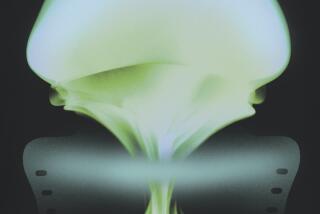‘Fantastic Voyage,’ under a modern-day microscope
MORE than most of its contemporaries, the 1966 scifi thriller “Fantastic Voyage” has stayed on the right side of the line separating vintage kitsch from risible camp. Directed by the versatile genre pro Richard Fleischer (“Soylent Green,” the underrated noir “The Narrow Margin”), written by Harry Kleiner and later novelized by Isaac Asimov, it’s perhaps the trippiest variant on the difference-of-scale conceit that has fueled fantasies from “Gulliver’s Travels” to “Honey, I Shrunk the Kids.”
“Fantastic Voyage” -- out this week in a special-edition DVD -- took the space-exploration fantasies of the 1960s and turned them inward.
The central gimmick is a miniaturization technology that the Americans and the Soviets are scrambling to perfect. A scientist who holds the key to this still-imperfect process -- it works for only an hour at a time -- has been critically injured in an assassination attempt by “the other side.” The only way to save the patient and unlock the secrets in his head is to try out this dangerous shrinking trick.
In a procedure that utterly redefines “invasive surgery,” a medical team is loaded onto a submarine, reduced to microbial proportions and injected into the comatose scientist’s carotid artery. The germ-sized crew members must then steer their ship toward the brain and destroy an offending blood clot with a laser gun.
Complicating matters, the team must complete the mission within 60 minutes; otherwise, their gradual reversion to normal size would prove fatal not only to the host body but also to themselves, as they become vulnerable to white blood cells on the attack.
The scientific basis is, to put it gently, sketchy, but that doesn’t stop the film from adopting the tone of an awestruck biology lesson. The voyage is essentially a series of obstacles, the nature and solution of which invariably illustrating the wonder of the human body. A forced detour through the heart requires the inducement of cardiac arrest to avoid turbulence. Confronted with a dwindling oxygen supply, the crew stops off to refuel at the lungs.
Another change of course sends them into the inner ear, which necessitates complete silence in the operating theater outside. Every so often, they don scuba-diving gear and leave their vessel to battle antibodies or remove seaweed-like blockage (and also so audiences can admire the curvy physique of medical assistant Raquel Welch).
Further evidence that the filmmakers are not all that interested in hard science: There is at one point a brief discussion between the surgeons that pits “intelligent design,” as it would come to be known, against evolution, with the latter viewpoint assigned to the nominal villain (as in almost all sci-fi expedition flicks, there’s a saboteur on board).
Fleischer, who died last year at age 89, had previously directed another submarine adventure, “20,000 Leagues Under the Sea” (1954), with Kirk Douglas, and he keeps the action here effectively streamlined. But the film’s most significant achievement is its indelible look, tactile and somewhat tacky. The inside of the human body evokes nothing so much as the psychedelic interiors of a groovy ‘60s nightspot, with the luminescent globs of plasma suggesting lava lamps.
“Fantastic Voyage” won Oscars for visual effects and art direction and had an ally in Salvador Dali, who helped promote the movie’s New York release (the publicity campaign is the subject of an amusing short by the documentarians Albert and David Maysles, unfortunately not among the DVD extras). From our current vantage point, the film’s appeal has less to do with surrealism than nostalgia. It’s a movie that potently evokes bygone attitudes and aesthetics -- a relic of the age of pre-digital effects, a product of both Cold War paranoia and midcentury techno-utopianism.
More to Read
Only good movies
Get the Indie Focus newsletter, Mark Olsen's weekly guide to the world of cinema.
You may occasionally receive promotional content from the Los Angeles Times.










